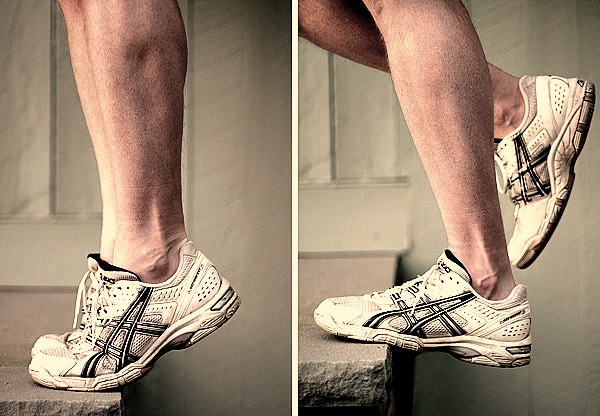How to treat Achilles tendon injury caused by heel strike running? Conventional strategies used to treat running-related Achilles tendon injuries typically include ice and rest; however new studies suggest these treatment methods may do collateral damage to the Achilles tendon and should not be used.
To date, the most effective way to treat an Achilles tendon injury is with with eccentric heel drop exercises, making forefoot running the best candidate for Achilles Rehab.
Forefoot Running = Eccentric Heel Drops
A big gain with forefoot running is its therapeutic for the Achilles tendon. Achilles injury is common in habitual shod runners who heel strike, but less common in habitual barefoot runners and forefoot runners.

Why is forefoot running therapeutic for the Achilles tendon? The heel-drop phase during stance in forefoot running is a form of eccentric calf muscle training.

The heel must drop to the ground to complete the eccentric activity of the Achilles tendon. The Achilles tendon is more sensitive to stress if the heel does not fully lower down -this is why it’s important to wear running shoes with no under-heel cushioning. The flatter the shoe, the better.
Do’s and Don’ts when Your Achilles Hurts when Forefoot Running
If you suffer Achilles tendon pain, even show bilateral swelling around the tendon, continue forefoot running being more cautious of your technique.
Wear pure minimalist running shoes with a firm sole and no under-heel cushioning to ensure complete dropping of the heel and better stability. It’s critical that the sole feels ‘hard’ under your feet, not ‘soft’ and ‘squishy’.
- Shoe cushioning destabilizes the ankle during stance and may cause a whipping action on the Achilles tendon. Remove the insoles from your shoes to get closer to the ground, with better ankle stability.
If you feel a sharp pain in your Achilles tendon when you run, walk it off and resume forefoot running. Never rest or ice! Here’s why:
Achilles Injury is a Noninflammatory Condition
Achilles ‘tendonitis’ is now called Achilles tendonosis because the condition was found to be noninflammatory. So why the swelling?
Swelling on the Achilles or on both sides of the Achilles (bilateral swelling) was found to be NOT caused by inflammatory cells, but rather the proliferation of a disordered arrangement of collagen fibers that are thinner than normal collagen fibers and are separated by large mucoid patches and vacoules.
- The absence of inflammation on the Achilles tendon renders icing as completely useless. In fact, icing results in poorer healing of Achilles injury and in recent papers, was considered an ‘aggravating activity’.
It would then follow that the anti-inflammatory action of NSAIDs would have no therapeutic effect because again, Achilles tendon injury is a non-inflammatory condition. In fact, Astrom et al. found that NSAIDs did little to help patients with Achilles injury and should not be used in management of Achilles tendinopathy.
Keep on Forefoot Running!
Forefoot running strengthens the Achilles tendon because of the eccentric action of the lowering of the heel during stance. Forefoot running with Achilles injury induces mechanical loading that accelerates tenocytes metabolism, speeding repair and breaks-up scar tissue.
You can still run, with a forefoot strike, when suffering an Achilles injury, just be smart about your running distance and intensity. Use this time to monitor your form to allow progressive strengthening in the treatment of the Achilles tendinosis.
More From Run Forefoot:
- Struggle with Knee Pain? Switch to Minimalism
- Barefoot Running Great for Runners with Low Arches
- Weekly Specials from Run Forefoot
- Different Rearfoot Mechanics in Forefoot Running Renders Orthotics Ineffective
- Running Shoes that Boosts Your Forefoot Running Technique
You May Like:
References:
Alfredson H, Lorentzon R. Chronic Achilles tendinosis: recommendations for treatment and prevention. Sports Med 2000;29(2):135–46.
Astrom M, Rausing A. Chronic Achilles tendinopathy. A survey of surgical and histopathologic findings. Clin Orthop 1995;316:151–64.
Carter N. The patient presenting with a painful or swollen joint. In: Brukner P, Khan K, editors. Clinical sports medicine. Sydney (Australia): McGraw-Hill; 2001. p. 770–8.
Cook JL, Khan KM, Maffulli N, Purdam C. Overuse tendinosis, not tendinitis: part 2. Applying the new approach to patellar tendinopathy. PSM 2000;28(6):31–46.
Kannus P, Jozsa L, Natri A, Jarvinen M. Effects of training, immobilization and remobilization on tendons. Scand J Med Sci Sports 1997;7:67–71.
Khan et al. The painful nonruptured tendon:clinical aspects. Clin Sports Med, 2003;22:711-25.
Bretta Riches
BSc Neurobiology; MSc Biomechanics candidate, ultra minimalist runner & founder of RunForefoot. I was a heel striker, always injured. I was inspired by the great Tirunesh Dibaba to try forefoot running. Now, I'm injury free. This is why I launched Run Forefoot, to advocate the health & performance benefits of forefoot running and to raise awareness on the dangers of heel striking, because the world needs to know.
Latest posts by Bretta Riches (see all)
- Cushioned Running Shoes Found to Be Bad for Ankles - 23/04/2024
- Forefoot Running and Achilles Pain - 19/04/2024
- Does Foot Strike Really Matter in Running? YES! - 17/04/2024

Leave a Reply